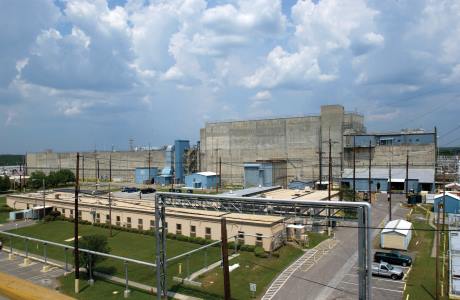Final solution for historic used fuel
29 August 2014
All of the used nuclear fuel from a historic US experimental reactor that ceased operations half a century ago has been dissolved in an equally historic chemical processing plant, completing a major step towards final disposition of the material.
 |
| H-Canyon, the only hardened nuclear separations plant still operating in the USA (Image: SRNS) |
Department of Energy (DoE) primary contractor Savannah River Nuclear Services (SRNS) completed the dissolution of 147 bundles of used nuclear fuel from the Sodium Reactor Experiment (SRE) at the H Canyon facility at the Savannah River Site. DoE authorised the processing of the fuel after determining that it was not suitable for long-term wet storage.
SRE operated at the Santa Susana Field Laboratory in California from 1957 to 1964, and was the first nuclear reactor in the USA to produce electricity for a commercial power grid. It used fuel made from a uranium-thorium alloy. After the reactor's closure, its fuel pellets were prepared for disposition by reactor builder Atomics International before being shipped to Savannah River's L Basin for storage in the 1970s.
The used fuel from SRE contains a high content of fissile uranium-233, which is generated by the absorption of neutrons by the thorium. According to SRNS acting environmental business manager George Zachmann this made it unsuitable for use as feed material for fresh nuclear fuel, the disposition route typically used for downblended uranium at the site. The SRE fuel has therefore been dissolved along with other high-aluminium fuel. The resulting solution will ultimately be vitrified at Savannah River's Defense Waste Processing Facility before final disposition.
The H-Canyon plant is itself a long-serving player in US nuclear history. Built in the early 1950s, the plant began operations in 1955 and is today the only 'hardened' chemical separations plant - that is, designed to withstand extreme events such as blasts and natural phenomena - still in operation in the US. The interior of the building resembles a canyon, with 2 metre thick dense concrete walls separating workers from the processing areas where work is performed remotely using overhead bridge cranes.
Historically, H-Canyon recovered uranium-235 and neptunium-237 from aluminium-clad enriched uranium fuel. It was also able to recover neptunium-237 and plutonium-238 from special irradiated targets, and played a vital role up to 2008 in the production of the plutonium-238 used to power numerous deep space exploration programs. In more recent years, the facility has continued to treat nuclear materials as part of DoE's environmental management program, and according to SNRS is likely to continue to operate at least to 2020.
Researched and written
by World Nuclear News